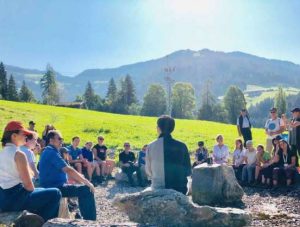
I went looking for my tribe and discovered that they are far-flung around the planet, seeded into different communities and cultures, but bound together in an intentional impact network of kindred spirits, namely engaged Buddhist practitioners.
Like some quantum entanglement, individuals appear in this Pure Land from other buddha-fields, with unique bodhisattva truths to impart. Thus was my encounter with Yingzhao Liu. It was her background in design thinking that piqued my attention when I first met her in a leadership training module for young people organized by Tung Lin Kok Yuen Buddhist Society Canada, where she was a presenter. She had been a User Experience design team director for LinkedIn for almost six years, helping to launch the Chinese edition of their platform.
In 2013, she left Seattle for the role at LinkedIn in the San Francisco Bay area, eventually finding Jikoji Zen Center, situated in a beautiful oak-and-laurel forest on the ridge that separates Silicon Valley and the coastal hills. She was a resident there for four years, eventually joining the center’s board of directors, before moving back to Seattle.
Her path to Jikoji was not a straight one. Yingzhao had previously worked as a designer and a hospice volunteer. Since 2004, she has also worked in outdoor, experiential education, the second main track of her journey. That’s where she learned a great deal about group dynamics, self awareness, and leadership. She says that’s where she first found her tribe.
I’m going to go out on a limb here and say that Jikoji was also a catalyst for Yingzhao to teach others how to find their tribes in impact networks, which is what she works at today with Converge. Their mission: cultivating impact networks for social transformation and supporting network leaders. Their services include catalyzing new networks, design and facilitation, training and coaching, cultivating existing networks, search and hire, and network evaluation. The Converge website also contains links to a 20-minute video about impact networks that Yingzhao co-produced, and a variety of resources and trainings. I recommend it highly.
To give you a sense of the kind of work they do, here’s a current example: they’re helping to build and facilitate an early education network for Washington State, involving many different agencies in the sector.
Why is this congruent with a Buddhist perspective and why is it important?
We Buddhists talk about Indra’s net, interbeing, and being a person of no rank. We see our relationship with the planet as one based on mutual respect and universal responsibility. Yet many of our Buddhist organizations are founded on hierarchical models. We don’t network or collaborate as much or as well as we should.
The network approach is a relatively new perspective, coming out of systems integration, cybernetics, and deep ecology. Think of it as complexity theory in practice. That last facet has been particularly relevant to the challenges of our modern world, such as climate degradation and biodiversity loss.
As Albert Einstein is reputed to have quipped: you can’t get yourself out of a problem with the same level of thinking that got you into it.
Yingzhao’s take on that is designing for integration. As she says, “I think Buddhism, perhaps more specifically non-duality, has a lot of overlap with complexity theory and the practice of that in today’s context, in active hope.”
So how do engaged Buddhists embrace this new approach? Yingzhao says a starting point for that conversation is to contrast hierarchies with networks—such as in nature. The training that emerges out of that organizational development would include teaching participants how to create flat, diverse, network structures to work for collaboration when people are used to the hierarchical mindset. And it would also involve investigation of conflict styles and deeper communication training, since Buddhists in the West are so often conflict-avoidant or too accommodating.
A case in point
Back in the 1980s, I was involved in the formation of the Buddhist Council of Canada (BCC). After the BCC’s revivification in 2011, it again fell into dormancy and existed more on paper than in reality, with a few modest projects such as the Buddhist Literary Festival for Canada that came and went but never created a groundswell of support or a feeling of belonging for most Buddhist organizations across the country.
Recently, the BCC’s founder and guiding light Bhante Mihita retired into a fuller solitary retreat, and has resigned from his role as the organization’s spokesperson and driving force. This sparked the formation of a new board of directors and a renewed interest in what the organization could and should be.
To that end, the new board convened a meeting to discuss a five-year plan, to which I was invited.
My first suggestion to the group was to adopt the Converge model, in which the Buddhist Council of Canada sees itself as a facilitator of Canadian Buddhist impact networks, helping the 550+ Buddhist organizations that exist here to better serve their communities. That is what I have been doing for more than 14 years with the Sumeru Guide to Canadian Buddhism directory, among other initiatives. So, I offered to give ownership of the directory to the BCC as a way of connecting with all the organizations they seek to serve. In fact, the directory has been offered to all and sundry for several years, with no takers, so that highlights one of the big challenges.
Yingzhao had mentioned to me in one of her letters that Buddhist organizations, like many advocacy groups, function from a mindset of scarcity rather than abundance: insufficient time, funds, and staff. The picture is further complicated by lack of digital savvy on the part of many sanghas, a serious constraint in our hyper-connected world.
She went on to say:
Admittedly, 550+ organizations would be a very large network, which takes a long time to catalyze. It’s good to start low-key, as a learning network, where the organizations can share learnings, challenges, and resources, either with events or a platform. There would need to be some coordination to support the flow and exchange. If there’s desire for some organizations to do more together, there’s a process to catalyzing impact networks:
• Clarify purpose and principles
• Convene the people
• Cultivate trust
• Coordinate actions
• Collaborate for systems change
This process is described in the Impact Networks book. There needs to be a focus for an impact network, and convening is ideally in person, so there would be quite a bit of work to do. It’s also perfectly okay to stay as a learning network—to have a directory and some information sharing. Also worth pointing out: impact networks rely more on purpose than on five-year plans because projects that come from trusted relationships and emergent needs are more likely to get done—we say, “things move at the speed of trust.” Top-down, long-term plans are very likely to remain on paper. The mostly-on-paper type of organization is a case in point that we need new ways of collaboration.

The BCC finds itself revisiting the first task, finding their purpose, and unable to move on to the second and third because they have not emerged organically from the larger community. They currently don’t have the connections or trust to exist authentically on the meta level that the name “council” implies, particularly keeping in mind the Buddhist councils of long ago. Attendees at the meeting agreed.
This lack of shared purpose, trust, and sense of belonging in the larger context of civil society are themes that have repeated themselves in many ways and times in Canadian Buddhist organizations. It is not something one can simply tackle head-on and vanquish. But it is a macro-fractal of the same difficulties that individual temples face in building their own local sanghas.
What would you contribute to the conversation?
More from Bodhisattva 4.0 by John Harvey Negru
Read more
Converge
Impact Networks: Creating Change in a Complex World, by Converge (YouTube)
Buddhist Council of Canada: The Definitive History (Sumeru Books)
Sumeru Guide to Canadian Buddhism












